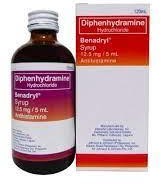A nurse is planning to administer diphenhydramine 1.25 mg/kg IV to a school-age child who weighs 55 lb. Available is diphenhydramine 50 mg/mL. How many ml should the nurse administer?
(Round the answer to the nearest tenth. Use a leading zero if it applies. Do not use a trailing zero.)
The Correct Answer is ["0.6"]
Rationale:
First, we need to convert the child's weight from pounds to kilograms. We can do this by dividing 55 by 2.2, which gives us 25 kg.
Next, we need to multiply the dose of diphenhydramine by the child's weight to get the total amount of medication needed. We can do this by multiplying 1.25 mg/kg by 25 kg, which gives us 31.25 mg.
Finally, we need to divide the total amount of medication by the concentration of the solution to get the volume to be administered. We can do this by dividing 31.25 mg by 50 mg/mL, which gives us 0.625 mL.
To round the answer to the nearest tenth, we look at the hundredths place and see that it is 5 or more, so we round up the tenths place by one. Therefore, the nurse should administer 0.6 mL of diphenhydramine IV to the child.
 |
Nursing Test Bank
Naxlex Comprehensive Predictor Exams
Related Questions
Correct Answer is A
Explanation
Rationale:
A. A child with cystic fibrosis needs a high-calorie diet to meet their nutritional needs and prevent malnutrition.
B. Sweat chloride testing is used to diagnose cystic fibrosis, not to monitor its progression.
C. Chewing pancrelipase medication before eating is incorrect. Pancrelipase should be swallowed whole with meals to aid in digestion.
D. Administering dornase alfa every 4 hours for wheezing is not appropriate. Dornase alfa is typically used for cystic fibrosis to help thin mucus and improve lung function, but it is not indicated for wheezing, and the dosing frequency provided is incorrect.
Correct Answer is C
Explanation
Rationale:
A. Storing opened vials of insulin for up to 60 days is incorrect. Insulin should be discarded after the manufacturer's recommended expiration date or within 28 days after opening, whichever comes first.
B. Physical therapy is not typically indicated as part of routine care for adolescents with type 1 diabetes mellitus. However, regular physical activity is encouraged for overall health and blood sugar management.
C. Consulting with a nutritionist is important for adolescents with type 1 diabetes mellitus to receive individualized meal planning guidance, carbohydrate counting education, and dietary recommendations to help manage blood sugar levels.
D. Monitoring capillary blood glucose daily is essential for adolescents with type 1 diabetes mellitus, but it is not the only recommendation. Comprehensive diabetes management includes multiple aspects such as insulin therapy, dietary modifications, physical activity, and regular monitoring of blood glucose levels.
Whether you are a student looking to ace your exams or a practicing nurse seeking to enhance your expertise , our nursing education contents will empower you with the confidence and competence to make a difference in the lives of patients and become a respected leader in the healthcare field.
Visit Naxlex, invest in your future and unlock endless possibilities with our unparalleled nursing education contents today
Report Wrong Answer on the Current Question
Do you disagree with the answer? If yes, what is your expected answer? Explain.
Kindly be descriptive with the issue you are facing.
